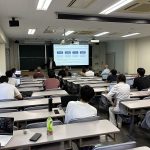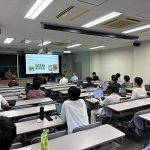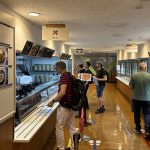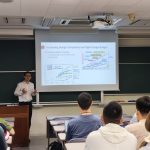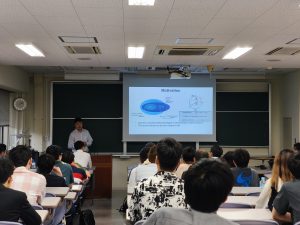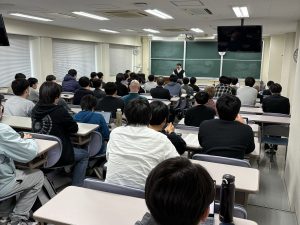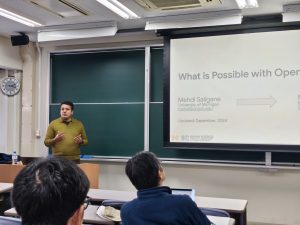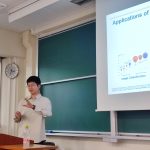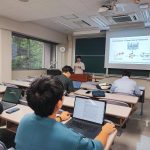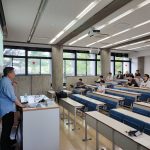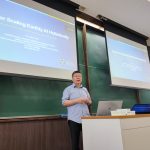IEEE CAS Industrial Distinguished Lectureとして、TSMCデザインテクノロジージャパンの新居浩二様による講演会が開催されました (2025/12/17)。
カテゴリー: Event
技術講演会
2名の著名な集積回路設計技術研究者が講座を訪問し、意見交換を行うとともに、以下の技術講演会を開催しました(2025/11/28)。
Title: Physical Design for Heterogeneous Integration: Challenges and Opportunities
Speaker: Prof. Yao–Wen Chang (National Taiwan University)
Title: Automated Finger Placement for Wire-Bonding Packages Using a Double-Square Analytical Framework
Speaker: Prof. Jai-Ming Lin (National Cheng Kung University)
FAU大学来訪・講演会
2025年9月30日から10月2日まで、ドイツFriedrich-Alexander-Universität Erlangen-Nürnberg(FAU大学)よりJürgen Teich教授の研究グループが我々の研究室を訪問し、研究交流を行いました。9月30日にはFAU大学が、10月1日には京都大学が主に発表をするセミナーを開催し、活発に議論を行いました。
技術講演会
4名の著名な集積回路研究者が講座を訪問し、意見交換を行うとともに、以下の技術講演会を開催しました(2025/6/9)。
Title: AI-Empowered Heterogeneous Computing for Physical Design Automation towards Timing Closure
Speaker: Prof. Yibo Lin (Peking University)
Title: Design-Agnostic Bi-Voltage Scaling for Efficient Cryo-CMOS DVFS
Speaker: Prof. Longyang Lin (Southern University of Science and Technology)
Title: Towards 2.5D/3D Composable Chiplets for AI Computing: Heterogenous Integration and Design Exploration
Speaker: Prof. Yu Kevin Cao (University of Minnesota)
Title: Co-Designing Algorithms and Hardware for Efficient Machine Learning System
Speaker: Prof. Caiwen Ding (University of Minnesota)
Jaijeet Roychowdhury教授講演会
研究室を訪問したU.C. BerkeleyのProf. Jaijeet Roychowdhuryによる、以下のセミナーを開催しました (2025/2/13)。
“Oscillator and Latch Ising Machines”
Abstract
——–
For many real-world applications (ranging from large-scale networking and the design/verification of mission-critical systems to drug discovery and 5/6G wireless systems), modern society has become increasingly reliant on rapid and routine solution of hard discrete optimization problems.
Over the past decade, fascinating analog hardware approaches have arisen that combine principles of physics and computer science with optical, electronic and quantum engineering to solve combinatorial optimization problems in new ways—these have come to be known as Ising machines.
Such approaches leverage analog dynamics and physics to find good solutions of discrete optimization problems, potentially with advantages over traditional algorithms.
These approaches are based on the Ising model, a simple but powerful graph formulation with deep historical roots in physics using which combinatorial optimization problems can be represented.
While the first Ising machines relied on quantum mechanical interactions, newer schemes have emerged that are based on purely classical (non-quantum) operational mechanisms.
Classical Ising machine schemes that can be implemented on chip have many practical advantages—eg., smaller physical size, lower cost, lower energy consumption, on-chip integration, scaling to large problem sizes and mass production.
About seven years ago, we discovered that the analog dynamics of networks of electronic oscillators resulted in their solving Ising problems “naturally”.
A few years later, schemes that use bistable latches in analog operation were also devised.
This talk will cover the principles and practice of oscillator and latch Ising machines, touching on similarities and differences.
Surprisingly, a common mathematical framework based on Lyapunov functions helps explain these machines’ remarkable optimization properties.
The design and implementation of practical integrated circuits with analog Ising cores that deliver proper optimization performance will also be touched upon.
Another key focus will be Ising machine performance on real-world applications.
Examples will include the MU-MIMO detection problem in modern wireless communications—we will show how it can be converted to Ising form, and how well it is solved by analog Ising machine schemes.
Our results indicate that near-optimal symbol-error rates (SERs) are obtained, improving over the industrial state of the art by 20x for some scenarios.
Seminar by Dr. Zheyu Yan
研究室を訪問したUniversity of Notre DameのDr. Zheyu Yanが、以下のセミナーを開催しました(2024/10/24)。
“Software-Hardware Co-Design of Neural Network Accelerators using Emerging Technologies”
Seminar by Prof. Jinjun Xiong
JSPS外国人招へい研究者プログラムで研究室に短期滞在中のUniversity at BuffaloのJinjun Xiong先生が、以下のセミナーを開催しました(2024/8/5)。
“Quest for Scaling Earthly AI Holistically
– Advancing AI to help children with speech and language service needs”
Seminar by Prof. Jingtong Hu
Pittsburgh大学のJingtong Hu先生がJSPS外国人招へい研究者プログラムで研究室に短期滞在し、滞在期間中に以下のセミナーを開催しました(2024/7/12)。
“Hardware/Software for Efficient, Independent and Inclusive On-device AI”



